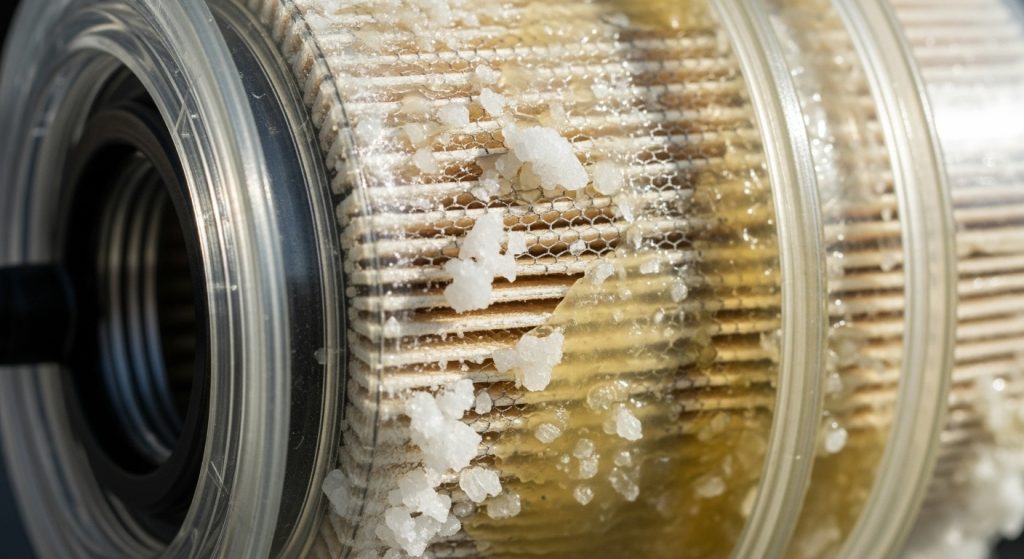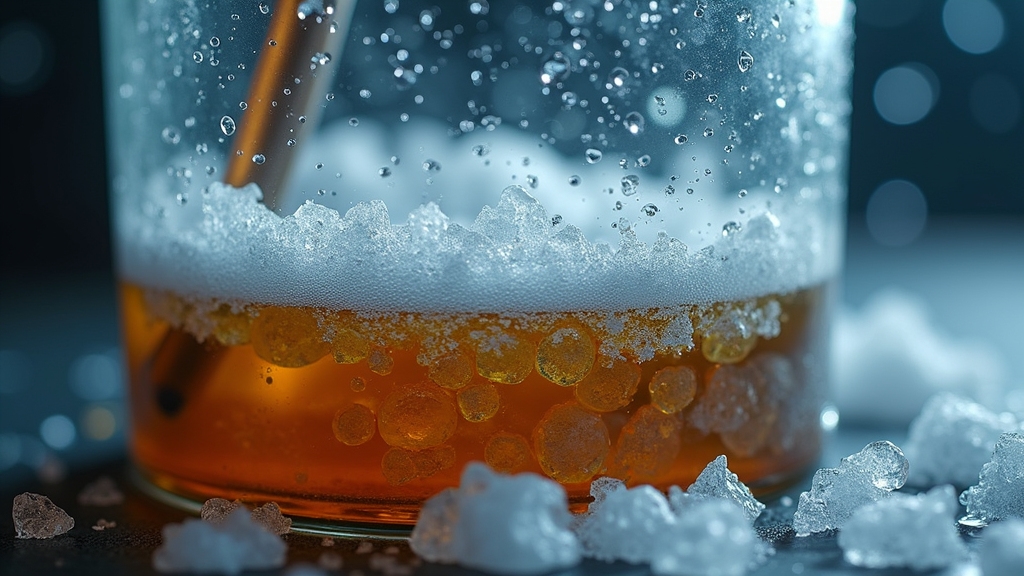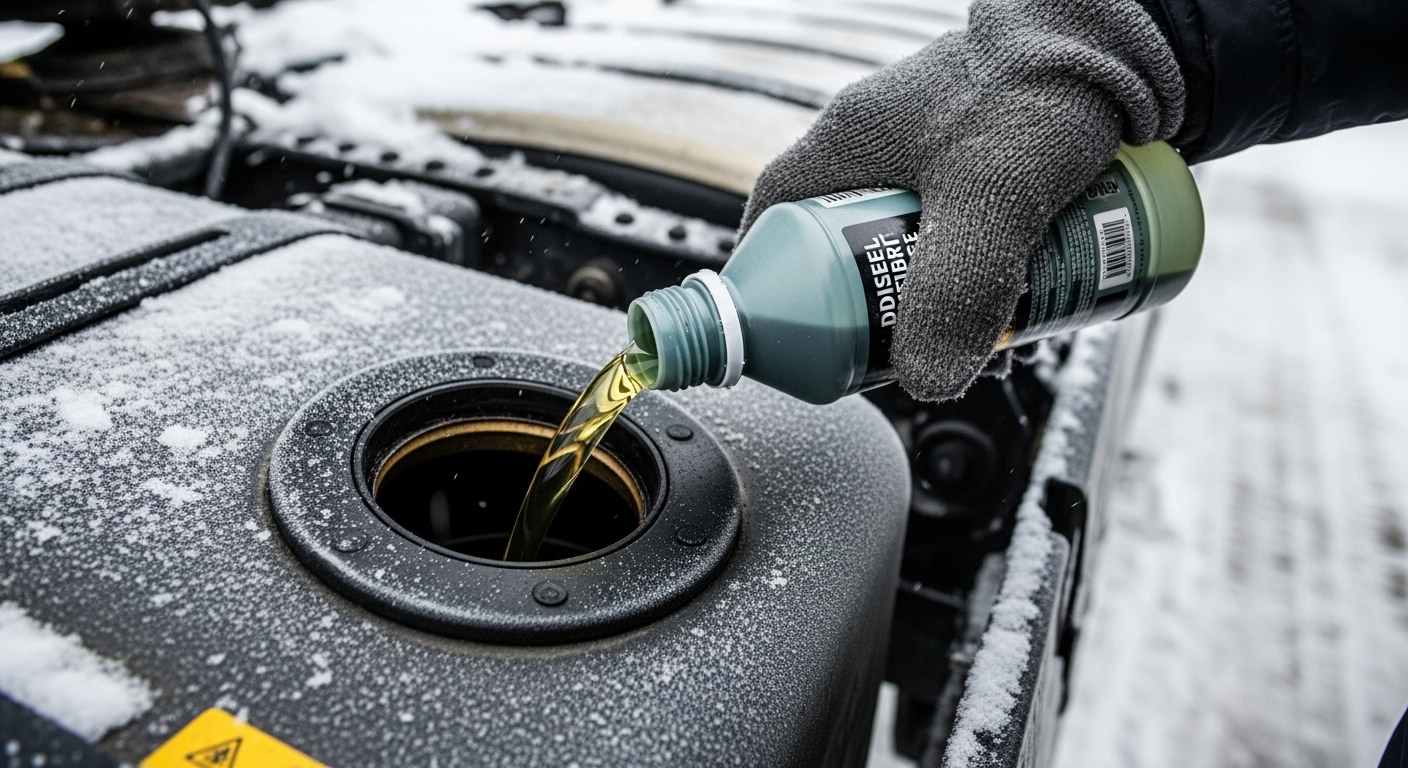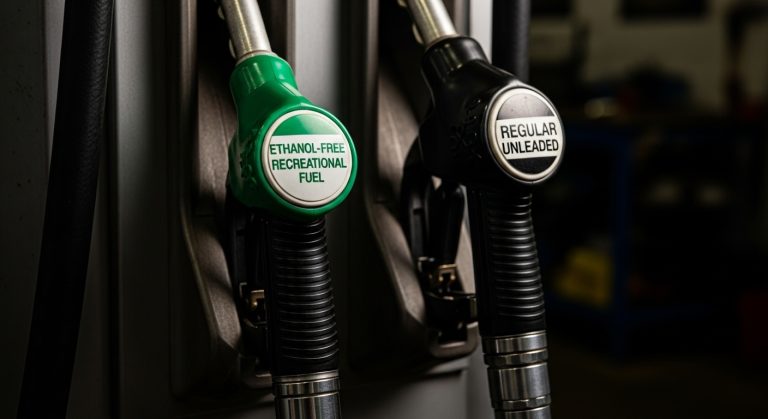You might think diesel fuel freezes like water, but it actually gels due to paraffin wax crystallizing at low temperatures—usually around 16 to 20°F.
This wax forms solid crystals that thicken the fuel, clogging filters and fuel lines, impairing engine performance.
Unlike freezing, this gelling raises viscosity and blocking risk well before true freezing occurs.
Water freezing in diesel can cause ice blockages near 32°F, but wax gelling is the primary cold-weather concern.
Understanding these differences helps manage diesel’s cold-weather issues effectively.
Key Takeaways
- Diesel fuel does not freeze solid like water but gels due to wax crystallization at low temperatures around 16-20°F.
- Wax crystals form at the cloud point, thickening diesel and potentially clogging fuel filters and lines.
- Water contamination in diesel can freeze at or below 32°F, causing ice crystals that block fuel flow.
- Additives and winterized diesel blends lower the gelling and freezing points, improving cold-weather performance.
- Proper fuel storage, filtration, and heating prevent diesel fuel gelling and ice-related blockages.
Why Does Diesel Fuel Composition Matter in Cold Weather?

Although diesel fuel is commonly perceived as a uniform product, it actually consists of a complex blend of hydrocarbons, primarily paraffins, naphthenes, and aromatics. Each component influences its low-temperature behavior.
When temperatures drop below the cloud point, paraffin wax crystals begin to form. This leads to turbidity and increased viscosity. As these crystals accumulate, they obstruct fuel filters at the cold filter plugging point (CFPP), impairing engine operation.
The cloud point for fuels from major pipelines in the eastern U.S. typically ranges between 16-20°F, marking the onset of wax crystallization and fuel gelling.
Additionally, water contamination exacerbates freezing issues by forming ice, which leads to filter blockages. Diesel freezing doesn’t yield a solid block but involves progressive wax crystallization. This culminates in the pour point where flow ceases.
Variations in composition, such as kerosene blending, adjust cloud and pour points, mitigating freeze risks. Understanding these compositional effects is essential to managing diesel’s cold-weather performance effectively.
The Role of Paraffin Wax in Diesel Fuel Gelling
When temperatures approach freezing, paraffin wax in diesel fuel begins to crystallize, directly impacting fuel flow and engine performance.
At around 32°F (0°C), dissolved wax transitions into solid crystals, increasing fuel viscosity and causing cloudiness.
Around 32°F, dissolved wax forms solid crystals, thickening diesel and causing visible cloudiness.
As temperature drops further, these crystals agglomerate, forming gel-like structures that obstruct fuel filters and lines.
This gelling impairs fuel mobility, risking engine starvation, hard starts, and power loss.
The paraffin content varies by diesel type; Diesel #2, with higher wax concentration, gels at higher temperatures than Diesel #1.
You can mitigate these effects by blending fuels or using cold flow additives, which disrupt wax crystal growth and lower the risk of filter plugging.
Understanding paraffin wax behavior is crucial for maintaining diesel engine reliability in cold environments.
Additionally, water contamination in the fuel can accelerate the gelling process by facilitating ice and wax crystal formation.
Key Temperature Points: Cloud Point, Gelling Point, and Pour Point

Understanding how paraffin wax behaves in diesel fuel leads directly to analyzing critical temperature points that affect fuel performance in cold conditions. You need to focus on three key metrics: cloud point, gelling point, and pour point.
These points are vital because they determine the operational limits similar to how antifreeze regulates temperature in engine cooling systems.
The cloud point marks when wax crystals first appear, causing cloudiness and increased viscosity. The gelling point, closely related, is where wax crystals begin to interlock, thickening the fuel.
The pour point represents the lowest temperature at which diesel remains fluid, below which it becomes semi-solid and ceases to flow.
Cloud point signals initial wax crystallization and filter clogging risk. ASTM D2500 is the standard test method for measuring cloud point. Gelling point indicates onset of fuel thickening and pump strain.
Pour point defines complete flow stoppage due to wax solidification. Variability arises from fuel composition and additives affecting these thresholds.
Cold Filter Plugging Point and Its Impact on Diesel Engines
Hey there! So, let’s talk about the Cold Filter Plugging Point, or CFPP for short. It’s really important because it tells us the lowest temperature at which diesel fuel can still flow through a filter without getting clogged up. Pretty neat, right?
Now, when the temperature drops below the CFPP, that’s when things can get a bit tricky. Wax crystals start to form, and these little guys can block the filters.
This leads to fuel starvation, which means your engine mightn’t perform as well as it should. Definitely not what you want to happen! Just like engine air filters prevent contaminants from entering, keeping the fuel filter clear is essential to avoid fuel flow restriction.
That’s why keeping an eye on the CFPP is super crucial. It helps ensure you can start your engine reliably in cold weather and keep everything running smoothly.
So, if you’re in a low-temperature environment, make sure you’re aware of the CFPP for your diesel fuel! Standard testing methods like ISO 11606 and ASTM D6371 are used to measure CFPP accurately.
Definition of CFPP
How low can diesel fuel temperatures drop before it risks clogging your engine’s fuel filter? The Cold Filter Plugging Point (CFPP) answers this by measuring the lowest temperature at which diesel passes through a 45-micron filter within 60 seconds.
Tested under ASTM D6371 or ISO 11606, CFPP pinpoints when wax crystals begin blocking flow, signaling a risk to your fuel system. It indicates the temperature at which fuel begins to clog filters due to wax crystal formation.
Upgrading vehicle components such as sway bar links can enhance overall performance in cold conditions, complementing proper fuel management.
Key aspects of CFPP include: It’s always lower than the Cloud Point, offering a practical cold operability measure. CFPP depends on wax crystallization and fuel composition, affecting filter clogging.
Regulatory standards mandate CFPP limits to ensure winter reliability. Additives can lower CFPP, extending operational temperature range without filter blockage.
Understanding CFPP helps you select and treat diesel fuel to avoid cold-weather failures.
Effects on Engine Performance
The Cold Filter Plugging Point (CFPP) directly influences engine performance by determining the temperature at which diesel fuel starts clogging fuel filters due to wax crystal buildup.
When temperatures drop below the CFPP, paraffin wax crystallizes, forming particles that block filter pores and interrupt fuel flow. This blockage causes hard starts, fuel starvation, or engine stalling before the fuel fully freezes. Understanding the performance characteristics of fuel flow under cold conditions is essential for maintaining engine reliability.
Modern engines with fine fuel systems are especially sensitive, making CFPP a critical parameter for reliable cold-weather operation.
While cold flow additives modify wax crystals to reduce CFPP and improve filter passage, improper dosing risks additional clogging.
Understanding CFPP helps you anticipate and mitigate cold-induced fuel flow issues, ensuring consistent engine performance in winter conditions. Modern high-performance filters raise the CFPP temperature, increasing the risk of gelation and filter plugging in cold environments.
Distinguishing Between Ice Formation and Diesel Fuel Gelling

Hey there! So, let’s break this down a bit. When we talk about ice formation, that’s basically water freezing in your fuel system. This usually happens when temperatures drop to 32°F or below, leading to blockages that can cause some serious trouble. Proper filtration and maintenance can help prevent moisture buildup and engine damage.
Now, when it comes to diesel gelling, that’s a different story. This process involves wax from the diesel fuel crystallizing, and it typically kicks in at lower temperatures, around 20°F and below. Diesel gelling occurs in three stages: cloud point, pour point, and gel point.
What happens is that the fuel thickens up, making it harder for it to flow.
Understanding these two issues is really important, especially if you want to accurately diagnose and deal with any cold-weather fuel problems you might encounter.
Ice Formation Effects
Although ice formation and diesel fuel gelling both impair fuel flow in cold conditions, they arise from fundamentally different processes that require distinct detection and treatment approaches. Antifreeze and coolant mixtures play crucial roles in preventing freezing issues in engines, highlighting the importance of proper fluid maintenance.
Ice forms when water contamination in diesel freezes into crystals, physically blocking fuel lines and filters. Gelling results from paraffin wax crystallization altering fuel viscosity. You need to recognize these differences to manage issues effectively.
Ice crystals can cause micro-abrasion in fuel systems, unlike wax gels. Ice forms at or below 32°F, while wax crystals appear near 18-20°F. Ice blockage leads to intermittent fuel flow loss and engine stalling. Water in diesel can emulsify and cause issues that exacerbate ice formation.
Prevent ice by minimizing water condensation and draining tanks regularly. Understanding these effects helps you detect ice formation early and apply proper mitigation measures through coolant maintenance.
Diesel Gelling Dynamics
When diesel fuel cools, you must distinguish gelling caused by paraffin wax crystallization from ice formation due to water contamination. Each disrupts fuel flow through different mechanisms.
Gelling occurs when paraffin wax in diesel crystallizes below the cloud point (~32°F), thickening the fuel and eventually solidifying it at the gel point (below 10–15°F for #2 diesel). The natural paraffin wax content in diesel is the primary cause of this wax crystallization.
This wax solidification clogs filters and fuel lines, restricting flow. In contrast, ice results from water freezing within the fuel system.
Ice crystals can exacerbate the problem by creating blockages that worsen under thermal shock conditions. While icing forms solid ice crystals that block lines, gelling involves wax crystals increasing viscosity and causing filter plugging at the Cold Filter Plugging Point.
Understanding these distinct phenomena is essential for diagnosing cold-weather fuel issues and applying appropriate treatments like additives or heating to maintain engine operation.
Effective Prevention and Treatment for Cold Weather Diesel Issues
Since diesel fuel tends to gel rather than freeze in cold weather, preventing and treating this issue requires targeted strategies that address paraffin wax crystallization.
You need to select winterized diesel blends, especially switching to #1 diesel as temperatures drop below 30°F. Using cold flow improvers is essential to maintain fuel fluidity in extreme conditions.
Adding cold flow improvers or anti-gel additives disrupts wax crystal formation, maintaining flow.
Blending #2 and #1 diesel fuels with additives further improves performance.
Also, storing diesel equipment in heated or sheltered areas minimizes gelling risk.
To treat gelling, warm the fuel system to melt wax and restore flow.
Clean or replace clogged filters, use kerosene as a flow improver if winter diesel is unavailable, and drain extensively gelled fuel to prevent engine failure.
Monitoring cloud point and Cold Filter Plugging Point helps you act proactively.
Because gelling is characterized by the formation of wax crystals, it can cause cloudy fuel, rough idling, and engine stalling if not managed properly.
Frequently Asked Questions
How Does Biodiesel Affect Diesel Fuel Freezing and Gelling Temperatures?
Biodiesel raises diesel fuel’s freezing and gelling temperatures, especially as its blend level increases.
If you use blends above B20, expect earlier gelling and filter clogging in cold conditions.
Lower biodiesel blends, like up to B5, behave similarly to petroleum diesel.
To maintain cold flow, you’ll need winterization techniques or additives, particularly with higher biodiesel content.
Biodiesel’s saturated fats promote crystallization and fuel solidification at higher temperatures.
Can Diesel Fuel Additives Harm Engine Performance or Emissions?
You might find that some diesel fuel additives introduce subtle challenges to engine performance and emissions. Certain formulations can elevate carbon monoxide and hydrocarbon emissions at low loads, while others may increase fuel consumption slightly.
Inappropriate additive use risks injector fouling or deposit buildup, impairing efficiency. To optimize outcomes, you should carefully select additives tailored to your engine and fuel, continuously monitor performance, and consider expert advice to balance benefits against potential drawbacks.
What Are the Signs of Diesel Fuel Gelling During Engine Operation?
You’ll notice engine hesitation, sputtering, and sluggish acceleration as fuel flow restricts from wax crystal buildup.
Starting becomes hard or fails altogether.
Watch for uneven idling with smoke due to poor combustion and a drop in fuel rail pressure under load.
Filters clog, causing fuel starvation and power loss.
As temperatures dip below 15°F, these symptoms intensify, often requiring fuel filter replacement to restore proper flow and engine response.
How Should Diesel Fuel Be Stored to Prevent Cold Weather Issues?
You should store diesel fuel in heated indoor spaces maintained above 32°F to prevent wax solidification.
Use climate-controlled garages or insulated outdoor tanks with temporary shelters to minimize temperature swings.
Keep tanks full to reduce condensation, drain water regularly, and employ water-absorbing filters.
Add winter diesel additives below 30°F to inhibit gelling.
Use sealed, corrosion-resistant containers with vent filters to prevent contamination and maintain fuel integrity during cold weather.
Are There Differences in Diesel Gelling Between Retail Brands or Suppliers?
Oh sure, every diesel brand is just dying to freeze in your tank. Said no quality supplier ever.
You’ll find some additives, like Hot Shot’s or PEAK, expertly prevent gelling even below freezing. Others, like Lucas, might as well be sugar in your fuel.
They vary chemically, affecting cold filter plugging points and wax crystal formation.
Don’t Let Winter Catch You Off Guard
You might think diesel fuel freezes like water, but it’s more like a slow solidifying puzzle, thanks to paraffin wax.
Understanding key temperatures—cloud point, gelling point, and cold filter plugging point—helps you anticipate when diesel will thicken and hinder engine performance.
By distinguishing fuel gelling from ice formation, you can apply precise prevention and treatment methods.
Remember, mastering diesel’s cold behavior keeps your engine running smoothly, even when winter bites hard.




